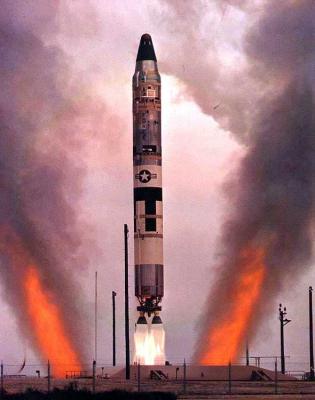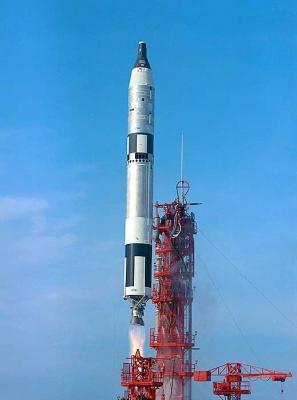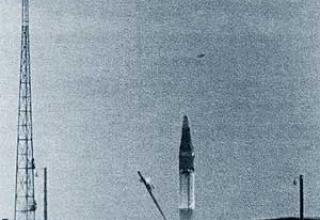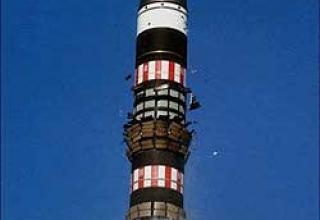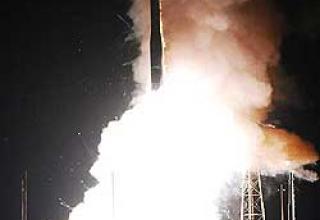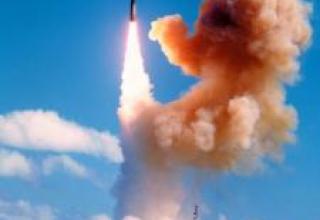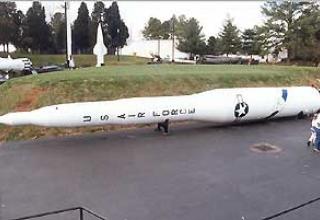Research efforts to improve the operational effectiveness of U.S. first-generation ICBMs (Atlas-D, E, F; Titan I) began even before these missiles were adopted into service. U.S. missile specialists immediately identified two weaknesses of the first ICBMs: the presence of cryogenic fuel components (liquid oxygen as an oxidizer) and the use of a radio-inertial navigation system. These factors significantly reduced the effectiveness of the first ICBMs, increasing the time required to launch a missile after receiving an order and forcing launch sites to be built relatively close to each other (for effective ground-based guidance systems), which significantly increased the probability of multiple ICBMs being disabled by a single thermonuclear strike at the same time. Studies to address these problems were conducted by the Air Force Ballistic Missile Division (AFBMD). The problems were partially solved by the latest modifications of the first-generation ICBMs, but in general this set of problems has not found a satisfactory solution.
In July 1958, after extensive research, AFBMD came to the conclusion that by deep upgrading the Titan-1 ICBM it was possible to obtain a missile with fundamentally new characteristics and combat capabilities. The following ways were outlined for modernization: application of high-boiling, self-ignition fuel components on the missile, increasing the diameter of the second march stage, application of forced engines on both march stages. In January 1959 it was decided to equip the upgraded ICBM with a fully inertial control system, which made it possible to place new missiles of the "single launch" mine launchers (SHU OS) and thus increase the probability of their survival in the event of a preventive thermonuclear attack by the enemy.
In November 1959, the Ministry of Defense instructed the Air Force to begin a program to develop a new ICBM, called "Titan-2" (system SM-68B, and since 1962 - LGM-25C). In turn, the Air Force designated the main contractors involved in the new project. The contractor to develop the missile itself and a number of its systems in June 1960 was named "Glenn L. Martin Aircraft Company" (later "Martin Marietta"). It was also named the main contractor for the project as a whole. Aerojet General Corporation was commissioned to develop the engines for both marching stages. The inertial guidance system was developed by AC Spark Plug. The development of the combat unit was entrusted to the company "General Electric". Based on the experience of the Titan-1 ICBM development and significant continuity, it was planned to put the system into service in October 1962. In this connection, as well as due to the high performance of the new ICBM, the plans to deploy the Titan-1 ICBM were reduced by half, from 108 to 54 missiles. In turn, the new ICBM was also planned to deploy 54 copies.
The development program of the new ICBM was given top priority and the results did not take long - in December 1961 the first ground tests of the new ICBM engines began. The first unit, which was to go on missile duty, was activated January 1, 1962, a few months before the first launch of the ICBM (570th Strategic Missile Squadron, 390th Strategic Missile Wing, Davis-Montan Air Base, Arizona). March 1, 1962 was activated 532nd Strategic Missile Squadron 381st Strategic Missile Wing, Maconnell Air Base, Kansas. The program of test launches was opened on March 16 of the same year by the successful launch of the Titan-2 from the Eastern Missile Test Range (Patrick Air Force Base, Florida). On April 1 of the same year, 373rd Strategic Missile Squadron, 308th Strategic Missile Wing, was ceremonially activated at Little Rock Air Force Base, Arkansas, and on May 1, 571st Strategic Missile Squadron, 390th Strategic Missile Wing, at Davis-Montan Air Force Base, Arizona. Units soon began putting the first ICBMs on combat duty. On August 1 and September 1 of the same year, 533rd and 374th Strategic Missile Squadrons were activated at McConnell and Little Rock Airbases, respectively, thus completing the structural formation of 3 strategic missile wings under the Titan-2 ICBM. The personnel of each wing was about 1,000 people. In turn, each wing consisted of squadrons - two strategic missile squadrons (9 missiles each) and one squadron of missile maintenance. In turn, each strategic missile wing was part of the aerospace division, which was part of a specific air army. Since 1978, the missiles "Titan-2" began to serve and female crews.
February 16, 1963 was the first (unsuccessful) launch of a new ICBM from the Western Missile Test Range (Vandenberg Air Force Base, California), after which it was made a rather risky decision to start the installation of missiles in the mines for combat duty - the first ICBM was put on duty on March 31, 1963, all 54 ICBMs were put on combat duty by January 1, 1964.
On 9 April 1964, the Titan-2 ICBM completed its final test launch in a series of 33 launches (of which 5 were unsuccessful). The Air Force began a series of party launches. The launch on April 9, 1964 was the last launch of the new ICBM from the Eastern Missile Range. Later on, all launches were conducted from the Western Missile Range. In 1964, 5 party launches were carried out (all successfully), which allowed the Air Force to announce that the missile system had reached full operational capability.
In 1965, the Air Force began training and combat launches of new ICBMs, which were performed by regular SAC crews. In 1965-1966, 19 launches were made (all successfully). At the end of 1964, the first comprehensive program to enhance the combat capabilities of the new complex began. It consisted of two main parts (subprograms): "Project Yard Fence" and "Project Green Jug". During the program, individual components and units of the ICBM engine, fuel, electromechanical and pneumatic-hydraulic systems were upgraded to improve reliability and ease of maintenance, a number of components and mechanisms of the launch complex were replaced, additional systems were installed to amortize the missile in the mine, to maintain the microclimate and communication systems. All this made it possible to increase the complex's resistance to ABI (especially to excessive pressure in the shock wave front and to seismodynamic soil displacement), to reduce the time from receiving the command for launch to the launch of the missile, and to increase the probability of bringing the commands to the higher control levels.
Training and combat launches of missiles of the improved complex began in 1966 and by 1969 inclusive 13 launches were made (all successfully, 1 more launch was canceled for technical reasons). In addition, during the same period, another Titan-2 ICBM was launched as part of a special test mission. The flight was completed successfully. Thus, by the end of 1969, a total of 71 ICBM launches had been made (of which 5 were unsuccessful). Another launch was cancelled for technical reasons. Thus, overall, the ICBM demonstrated a fairly high level of reliability. However, this period of ICBM operation was marred by two tragic accidents in operating units - on August 9, 1965, during modernization work, hydraulic fluid ignited due to welding sparks at one of the mines of Little Rock Air Base. The smoke and flames killed 53 engineers and workers who were working in the mine at that time. Two more managed to escape. The incident damaged (but did not explode) the ICBM, which was standing in a refueled state in the mine, but without a HF. The mine was also damaged and did not come back into operation until 13 months later. On January 28, 1968 in the same missile wing during the rocket inspection work fell from the height and one of the crew members died.
In 1971, a new phase began for ICBMs: training and combat launches were associated with testing the radar component of the then-established Safeguard Zonal BMD system. During these tests, the Titan-2 ICBM simulated Soviet R-36 heavyweight ICBMs and partially R-36O ICBMs. During the period 1971-1974, 6 launches were made under this program (all successfully), while 2 more launches were cancelled for technical reasons. In 1975, there were three more launches under two different programs - the special test program (1 launch, successful) and the missile defense system test program (2 launches, successful).
In 1976, the Titan-2 ICBM made its last (and successful) combat training flight, which was part of the testing of a new inertial control system such as the "Universal Space Guidance System" developed by Delco Carousel.
The initial warranty period for this ICBM was 10 years, but during the lifetime of this ICBM in the U.S. Air Force SAC Continuous Readiness Force, the warranty period has been extended several times. The extension was carried out under the Ageing Technical Surveillance Program/Resilience Enhancement Program; the program's purpose is to extend the warranty period of the launch complex and the missile as a whole, except for the LRBM; the program's purpose is to extend the warranty period of the launch complex and the missile as a whole.
In the second half of the 1970s, the Titan-2 missile system underwent another upgrade, the main element of which was to equip the ICBM with a new inertial control system, which made it possible to improve the missile's firing accuracy and ABI resistance. In addition, the launch complex underwent some modernization, including increased resistance to PFCs (especially electromagnetic pulses and elementary particle flows), increased probability of bringing control commands from higher levels, and completely updated test equipment.
In the second half of the 70s and early 80s, several fatalities occurred in ICBM operating units, of which 2 were the most severe accidents. October 8, 1976 in the mine missile wing of Little Rock base (by the way in the same mine where the worst accident occurred on August 9, 1965) during the cleaning of hydraulic fluid suffocated one of the crew members. Severe accident occurred August 24, 1978 in the rocket wing, based at the airbase McConnell. Due to a large leak of toxic oxidizer during the refueling procedure of the ICBM caused significant damage to the ICBM and the mine itself, killing 2 and injuring 25 personnel. Residents of nearby towns were evacuated for some time. An attempt to reactivate the SLBM was made as a result of the Project Pacer Down program, which was decided to begin in September 1980, and work began in August 1981, with an expected completion date of January 1982. However, given the decision by U.S. senior leadership in October 1981 to decommission the Titan-2 ICBM, nearly completed rehabilitation work was halted by December 1981. The launch complex was mothballed, and then, along with other similar types, was destroyed.
The accident with even more serious consequences happened on September 19, 1980 at one of the launch complexes of the traditionally unhappy wing of the air base Little Rock. While carrying out the work to increase the pressure of the supercharging in the oxidizer tank of the second stage, the technician who was carrying out the work, dropped a heavy tool that broke through the fall of the fuel tank of the first stage. The personnel of the launch complex were evacuated after the arrival of a mixed team of military and civilian specialists to eliminate the accident. A team of 2 people was sent to the mine for reconnaissance, whose instruments registered the presence of explosive components in the mine. The order was issued to evacuate the reconnaissance team and the mixed team, but it was too late - the most powerful explosion of tens of tons of self-ignition fuel components shook the district. The shock wave of the detonating first stage ripped out the closed reinforced concrete mine cover weighing 740 tons, after which the second stage together with the HC were ejected from the mine. The damaged second stage flew out of the mine and exploded with several tens of tons of extremely toxic fuel, as a result of which the HT was thrown 200 m in the air and was damaged and destroyed in the fall. The accident killed 1 person and injured 21 others. The ICBM and the mine were completely destroyed (the mine was never rebuilt). Residents of nearby towns were evacuated for a while.
As a result of the investigation, in October 1981, U.S. President Reagan decided to deactivate all Titan-2 ICBMs by 01.10.1987. The deactivation operation, called "Rivet Cap", began on July 2, 1982 at Davis-Montan Air Force Base, when for the purpose of testing the ICBM launch complex 571-6 was removed from the ICBM's ICBM control system, as a result of which this complex formally became the first complex removed from combat duty as part of "Rivet Cap". The official date of the start of the operation is September 30 of the same year, when the same complex 571-6 was removed from combat duty. After dismantlement of the GC and drain of the fuel components, ICBMs (traditionally for the U.S. Air Force) were removed from the mines and sent for storage at Norton Air Force Base in California (curiously, after the closure of Norton Air Force Base, all remaining Titan-2 ICBMs returned for further storage at Davis-Montan Air Force Base), after which all valuable equipment was removed from the launch complex, the mine exploded and was filled with gravel and earth, underground tunnels were poured with concrete, command posts and entrances/exits were sealed, welded and also poured with a layer of concrete (an exception was made for only one complex at Davis-Montan Air Base, which has become a museum, in the mine of the complex is a training ICBM). The first launch complex (570-7) was destroyed there on November 30, 1983.On December 1 of the same year, the SAK Air Force ceased training new personnel for this type of ICBM.2 On April 2, 1984, however, the program of taking ICBMs out of service was temporarily suspended (until May 25) by the General Staff of the Air Force due to the temporary suspension of industrial facilities for storage and processing of liquid fuel components.31 July 1984, the 390th Strategic Missile Wing (Davis-Montan Air Force Base, Arizona) was disbanded, by which time the 381st Strategic Missile Wing (McConnell Air Force Base, Kansas) had already been deactivated for about a month (from July 2). It was there that November 2, 1984 during the procedure for unloading fuel components from ICBMs, which stood in the NSR, there was a major fire, but the procedure for deactivation of the missile system was again suspended and resumed only in January 1985. 381st wing was officially disbanded on August 2, 1986. April 24, 1985 began the deactivation of ICBM and the 308th strategic missile wing (Air Force Base Little Rock, Arkansas), the last ICBM of this wing was taken off combat duty May 5, 1987, and the wing itself was disbanded August 18 the same year. History of the Titan-2 ICBM - "Dinosaur among ICBMs". (as the U.S. racers called her) is over.
It should be noted that with the end of the combat service of the Titan-2 ICBMs, a new application was found for used missiles - as a conversion liquid-propellant booster. In 1986, the Ministry of Defense issued an order to convert 8 of the 54 ICBMs available for conversion into boosters. In 1987, an order was issued to convert 6 more ICBMs. The booster was named "Titan-2G" and was mainly used to launch military and dual-use satellites. The first launch of the boosters from the Western Missile Range took place in September 1988. The last launch took place in October 2003. A total of 13 launches were made (2 of them failed, but the reasons for the failures were not related to the booster itself). It was decided to abandon further operation of the complex, despite the presence of a fairly substantial fleet of sealed ICBMs (about two dozen). The high cost of upgrading and testing the ICBMs, as well as the low technical reliability of a number of systems noted in the last two launches (which was associated with a fairly decent age of the ICBMs used in the program) were cited as the main reasons for the refusal.
The history of the Titan-2 ICBM will be incomplete without talking about another aspect of the application of the upgraded version of this missile - as an LV in the implementation of the American manned space exploration program "Gemini". A number of changes have been made to the design in order to adapt the missile for the launch of a manned spacecraft with a crew on board. The main change was the replacement of the ICBM inertial control system by the Mod III (G) radio inertial control system developed by General Electric Corporation. In addition, a number of changes were made to improve the reliability of a number of systems, telemetry installations, etc. The main change was the replacement of the ICBM inertial control system by a radio-inertial control system Mod III (G) developed by General Electric Corporation. Initially, the plan provided for reservation of 15 upgraded Titan-2 missiles for NASA. Later, due to the increase in the cost of the program as a whole, the number of reserved missiles was reduced to 12. The first test run of the program was held April 8, 1964, the second and final - only January 19, 1965. After that it was decided to start manned flights, the first launch under the program took place March 23, 1965, and the tenth and last - November 11, 1966. In total, between 1964 and 1966, the Gemini programme made 12 launches - all of which were successful, although not all of the tasks were completed in individual flights due to problems unrelated to the launch vehicle.
Assessing the project as a whole, it should be noted that for the period of the late 50s - early 60s, American engineers and scientists managed to create a truly perfect missile, the most powerful ICBM in the arsenal of the U.S. Air Force SAC of that time. Only Soviet specialists managed to create a more powerful liquid-propellant heavy intercontinental ballistic missile, R-36, which began to arrive at the USSR's Strategic Missile Forces in 1967. The Soviet specialists managed to achieve much greater success not only in construction, but also in reliability of liquid-propellant ICBMs operation, which is a legitimate pride of our country. The Americans, on the other hand, failed to do so - for almost a quarter of a century of operation of a relatively small fleet of Titan-2 ICBMs, 4 severe accidents occurred with a large number of dead and wounded, and during these accidents ICBMs and launch complexes were seriously damaged. Nevertheless, the Titan-2 was a truly outstanding missile design for its time - even in 1975 (10 years after the completion of Titan-2 deployment), this type of missile, representing only about 5% of the total number of U.S. ICBMs, could deliver more than 37% of the total megatonnage of all U.S. ICBMs. On the other hand, the longevity of this missile can also be explained by the fact that for a long time it simply did not have a worthy replacement, which delayed its withdrawal from service (while the USSR, in response to the rapid growth of U.S. nuclear forces' capabilities, steadily improved its liquid-propellant heavy-class ICBMs - R-36, R-36O, and then R-36M, R-36MUTTX, R-36M2 Voevoda). Even the arrival of the latest solid-fuel LGM-118A "Peacekeeper" ICBM in a limited number for the U.S. Air Force SAC and its installation in the upgraded shafts of LGM-30G "Minuteman-3" missiles was in many ways a measure forced, just by this time the project to deactivate the ICBM "Titan-2" has already started, and the Americans urgently needed to "demonstrate their national will" (the decision was taken by President Reagan on the results of the commission of General B. Voyevoda). Scowcroft Commission).
According to published data, during 1962-1967, 131 missiles were fired, 12 of them in a modified version as boosters for the Gemini manned flight program. In addition, the Titan-2 ICBM served as the basis for a whole family of U.S. heavy launch vehicles (Titan-3, Titan-3A, Titan-3B, Titan-3C, Titan-3D, Titan-3E, Titan-34B, Titan-34D, Titan-4A and Titan-4B), the use of which for civilian and military launches was finally discontinued only in 2005. In more than 41 and a half years from 1962 to 2003, 106 launches of the Titan-2 were made in various versions under various programs, of which only 5 failed due to problems with the missile itself.
Composition:
The intercontinental ballistic missile "Titan-2" was a two-stage missile, whose stages were connected along a longitudinal pattern. The fuel tanks of both stages of the missile had a supporting structure and were welded from panels made of a special, lightweight and high-strength aluminum alloy with copper admixture.
The first stage was equipped with a rocket engine LR87-AJ-5 (see diagram), which had two combustion chambers made of special steel with independent supply of their fuel components. As a fuel on both stages of the rocket was used "aerosine-50" (a mixture of equal shares of asymmetric dimethylhydrazine and monomethylhydrazine), as an oxidizer - nitrogen tetraoxide. Cooling of combustion chambers was carried out with circulating fuel. The combustion chambers were fixed on a special steel frame so that their draught vectors were deflected by 2 angular minutes in different directions from the vertical. To control the rocket through the channels of pitch and yaw at the 1st stage, the combustion chambers could deflect in their hangers at angles up to 5°. There were no tilt channel controls in the 1st stage operation area. Each combustion chamber is equipped with an independent turbo-pump unit (TNA). Each TNA includes fuel and oxidizer pumps, a gearbox and two balanced turbines. The turbine speed reached 23,000 rpm, and to reduce the gyroscopic effect, the pumps had the opposite direction of rotation. To start the TNA, before ignition of the 1st stage engine, a special solid fuel engine - pyrostarter (duration of operation 1s), which spun the turbines, after which oxidizer and fuel valves were opened. This process was initiated 30s before the ignition. Before the start, the tanks of the first stage were inflated with nitrogen, and in flight the inflatation was carried out by means of a special gas generator system. The first stage engine was switched off by triggering a special sensor that recorded the pressure drop in the combustion chambers, after which the control system generated a signal to switch on the second stage power plant. Separation of stages was carried out according to the so-called "hot gas-dynamic" scheme, i.e. when the engine of the second stage is running. The hot gases were removed from the interstage space through two sets of special holes of different diameters.
The second stage was equipped with a single-chamber rocket engine LR91-AJ-5 (see diagram) on a special steel frame. To control the missile through the channels of pitch and yaw on the 2nd stage, the combustion chamber could deflect in its suspension to an angle of 4°. The tilt channel control in the 2nd stage operation area was performed with the help of a rotating nozzle fed by a special gas generator. To start the TNA, before the 2nd stage engine ignition, a pyrostarter (duration of operation 1s) was triggered, spinning the turbines, after which the oxidizer and fuel valves were opened. Almost the entire expanding part of the LR91-AJ-5 engine nozzle was uncooled and made of glass fiber with asbestos coating. Reducing the size of the cooled part of the engine combustion chamber made it possible to simplify the fuel supply system and ensure better reliability. Before starting, the second stage tanks were inflated with nitrogen, and in flight the fuel tank was inflated with a special gas generator system. The oxidizer tank was not inflated in addition to the initial nitrogen boost. The second stage engine was switched off by means of a special sensor which recorded the pressure drop in the combustion chamber, after which the control system generated a signal to switch on the power plant of accurate trajectory correction.
The Precision Trajectory Correction Power Unit consisted of two solid fuel engines, which were started simultaneously for final corrections in height and speed. After their operation was completed, the pyrolocks holding the head end were triggered. Next, the block of motors for withdrawal and orientation was switched on, and also KSP PRO was triggered. The block of thrust and orientation motors was represented by two solid fuel motors, which were ignited in series and operated 3s each. With their help the stage was moved away from the HF and oriented to be directed to the dense layers of atmosphere with the help of two special solid propellant reduction motors that were launched simultaneously after the end of the HF and orientation motor unit and also operated for 3s each.
The missile was equipped with a monoblock thermonuclear warhead, which consisted of an Mk6 combat unit with ablation-type thermal protection and a 9Mt W-53 combat unit. This BC was the most powerful of all U.S. ICBMs. To increase the probability of overcoming the ABM of a probable enemy, the missile was equipped with an ABM booster consisting of lightweight inflatable decoys and dipole reflectors. For the period of the early 1960s, such a BMD SSP was quite a serious achievement.
Inertial control system of "AC Spark Plug" company provided KVO no more than 1.6 km and was built on the basis of on-board computer with the speed of 6000 operas/sec. A lightweight magnetic drum with a capacity of 100,000 units of information was used as a storage device, which allowed storing several flight missions for hitting various targets. After receiving a command from the launch control station, the missile control system provided automatic prelaunch preparation and launch for 2 minutes (after the modernization activities this interval was reduced to one and a half minutes). One of three possible flight missions and one of two options to detonate a warhead - contact or airborne - could be introduced. By the beginning of the second half of the 70's all missiles were equipped with a new inertial control system such as "Universal Space Guidance System" by "Delco Carousel", which provided KVO no more than 1 km and increased resistance to radiation effects of nuclear weapons. This system was manufactured using a new element base based on the control system developed by the same company for Titan-3 boosters. Thanks to this system, in the second half of the 1980s, after decommissioning ICBMs, the process of converting the combat system into a launch vehicle was carried out very quickly. This made it possible to significantly reduce the development, production and maintenance costs of the system and made it very easy to convert ICBMs to Titan-2G boosters in the second half of the 1980s. After the upgrade, the weight of the control system was reduced from 162 kg to 57 kg.
The rocket launcher system (see diagram) was a reinforced concrete control system connected by a 76-meter-long tunnel to an underground control point. In the middle part of the tunnel there was a volumetric room of rectangular shape made of reinforced concrete. This room played a serious role - it contained the main entrance to the starting complex, an 11-meter-long downhill staircase and a freight elevator. The tunnel of the launch complex could be accessed by going down the stairs, after which it was necessary to go through the so-called "blast lock", i.e. doors made of special steel, weighing 2.7 tonnes each. The "blast lock" included four doors, of which only one could be opened at a time, and served as a protection of the command post (and the control room) from the nuclear blast wave, which could pass through the entrance, also "blast lock" protected the control room from the consequences of the explosion of the missile in the control room, withstanding the excess pressure in the front of the shock wave of at least 70 kgf/cm2. In addition, this room "blast lock" were auxiliary mechanisms, stored special protective suits (in which the crew examined the missile), showers for decontamination suits and for personnel.
The OS slurry was highly resistant to PFBS and could withstand excessive pressure at the shock front of at least 21 kgf/cm2. After the upgrade, this value increased to about 25 kgf/cm2. For the first half of the 1960s, this was a serious result. The mine was 45 meters deep and 17 meters in diameter, closed with a special reinforced concrete roof weighing 650 tons (later increased to 740 tons), rolled on two tracks. The opening time of the SHPU roof was 20s and later it was reduced to 17s. Since the missile was launched directly from the mine by the hot gas-dynamic scheme with the launch of the first stage engines inside the mine, the mine head was equipped with a flame deflector, two gas ducts and a water tank to cool a number of units and reduce the level of acoustic influence on the structure. In the shaft, the missile is mounted on a swivel ring reinforced with several shock absorbers. SHDs of the OS were built from each other at a distance of 11 to 16 km, which ensured quite sufficient survival of missile compounds in the event of a preventive thermonuclear impact.
The control room was a three-storey structure with a diameter of about 11 meters, round in a horizontal plane, made of reinforced concrete and had a hemispherical roof. All three tiers had a special shock-absorbing system to reduce the impact of PSNF (primarily seismodynamic soil displacement and excessive pressure at the shock front). The shock absorber system could withstand an impact load of at least 7 kgf/cm2. On the first tier of the KP there was a kitchen, shower room, rest and sleep areas. On the second tier, where one could go down a metal staircase, there were control panels and a number of devices and mechanisms, including consoles for rocket launch. The rest of the mechanisms and the emergency exit via the vertical staircase were on the third tier, which also had a metal ladder.
A crew of 4 people (two of them officers) was on 24-hour duty at the control room:
- MCCC (Missile Combat Crew Commander),
- DMCCC (Deputy Missile Combat Crew Commander),
- BMAT/ MSAT (Ballistic Missile Analyst Technician / Missile Systems Analyst Technician - Ballistic Missile System Technician / Missile Device System Technician)
- MFT (Missile Facilities Technician - rocket systems and equipment technician).
The last two specialists on duty once necessarily made a long detour of the main systems and equipment of the missile system (including ICBMs), which took up to 6 hours. As a rule, at least three crews, each with an alphanumeric designation (e.g., S-138), were assigned to one launch complex at the same time. The entire launch complex (including ground structures, antennas, etc.) occupied an area of 183x183 m fenced with barbed wire under alarm. In addition to the alarm system, security measures included searchlights, motion detectors and television surveillance of the most important places in the launch complex. Security was also provided by special police units of the Air Force. The officers of the crew had personal weapons. The crew had multiple duplicated radio and telephone communications with all necessary structures. During the time the complex was on combat duty, the probability of bringing the signal to the launch by upgrading the existing and installing additional communication systems increased significantly.
Characteristics:
| Range of fire, km | 15 000 |
| Length assembled, m | 32,92 |
| Diameter, m | 3,05 |
| The length of the first step, m | 22,28 |
| Second step length, m | 7,86 |
| Launch mass of the rocket, t | 150,51 |
| Gross mass of stage 1, t | 117,87 |
| Gross mass of stage 2, t | 28,94 |
| The mass of the empty 1st stage, t. | 6,74 |
| The mass of the empty 2st stage, t. | 2,4 |
| Weight of combat equipment, t | 3,7 |
| Stage 1 traction at sea level, kN | 2 000 |
| 1st stage traction in vacuum, kN | 2 172 |
| Specific impulse of the 1st stage at sea level, s | 258 |
| Specific pulse of the 1st stage in a vacuum, s | 296 |
| Stage 1 operating time, s | 139 |
| 2nd stage traction in vacuum, kN | 445 |
| Specific impulse of the 2nd stage at sea level, s | 316 |
| Step 2 operating time, s | 180 |
| Maximum flight altitude HF, km | 1 380 |
| Header type | monoblock, thermonuclear |
| HF power, Mt. | 9 |
| KVO HC, km | 1.6 (1 after equipping the new INN) |
| Type of navigation system | inertial |
| Maximum flight speed, km/h. | 29 000 |
Testing:
Testing of the complex began on April 21, 1995 at White Sands Range and continued with varying success until 1999. Only the ninth launch, on March 29, 1999, demonstrated the performance of the complex as a whole. During this flight, despite the failure of the interceptor's spatial orientation system for 23 seconds of flight and the termination of telemetry data reception for 58 seconds, the interceptor passed in close proximity to the Hera target missile.
During the tenth test launch on June 10, 1999, for the first time, a target simulating a SKAD missile was successfully intercepted and the technical feasibility of such an intercept was confirmed.
On 2 August 1999, during the eleventh test, a target simulating a detachable SCAD-type ballistic missile head in the upper atmosphere was intercepted.
Sources:
- To defend and deter: the legacy of the United States Cold War missile program / J.C. Lonnquest and D.F. Winkler. USACERL, 1997.
- From Snark to Peacekeeper: a pictorial history of Strategic Air Command missiles / SAC HQ Office of the Historian, 1990.
- Alert operations and the Strategic Air Command, 1957-1991 / SAC HQ Office of the Historian, 1991.
- A Salute to Little Rock AFB - 1962 directory and guide / C.F. Boone nationwide publications, inc., 1962.
- Titan I and "Titan-II" site activation manual / Martin Co. Denver, 1960.
- Interim engineering report for "Titan-II" deactivation / Martin Marietta Co. Denver, 1982.
- "Titan-II" dismantlement. Davis-Monthan A.F.B., Arizona. Final Design Analysis. / USACE, 1983.
- US Strategic and Defensive missile systems 1950-2004 / M.A. Berhow and C. Taylor. Osprey Publishing Ltd., 2005.
- www.titan-ii.com
- www.titan2icbm.org
- www.strategic-air-command.com
- www.astronautix.com
- www.nuclearweaponarchive.org
- www.globalsecurity.org
- www.nasa.gov
- www.arms.ru
